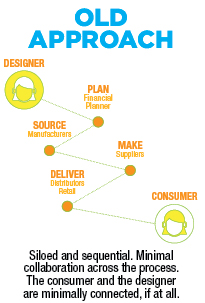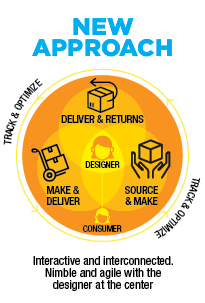The Human-Centered Supply Chain
The fashion supply chain is moving toward a human-centered model, which shifts from a sequenced approach of siloed operations to a flexible network of participants and partnerships that will enable agile and adaptable supply chain operations (see chart). That’s according to a new report developed by the Council of Fashion Designers of America, which worked with DHL, its official logistics partner, and in collaboration with innovation partner Accenture.
With a human-centered lens on design, manufacturing, and delivery, this model puts designers at the center of supply chain operations, empowered to build their networks through collaboration and by using digital tools and new business models to increase their flexibility in an industry that is currently in flux.
The human-centered supply chain benefits partners across traditional supply chain steps—from designers and material suppliers to factories and logistics partners—by focusing on relationship-building; enabling the sharing of expertise across partners; adopting collaborative approaches and shared communications; employing a networked approach to reduce costs and overall waste; and connecting partners across traditionally siloed steps to increase operational flexibility, according to the report.
The report identifies the following four key areas of focus to anchor insights and opportunities, driven by digitalization and the increase of e-commerce:
1. Process ownership. A process with clear communication channels across partners will increase flexibility in sourcing, producing, and delivering collections, and a well-defined—but flexible—approach will create more successful refinements. The key is to focus on process as a major component of design, integrating partners early on with clear communication of requirements about traceability and sustainability (if relevant), and including a dedicated step to integrate learnings from season to season.
2. Relationship building. Developing and nurturing relationships with supply chain partners, from mentors and experts to like-minded peers, is critical to success. Companies should focus on a relationship-first rather than transaction-based approach that identifies partners to collaborate with—to fill gaps in expertise, leverage passion points (such as sustainability), and create opportunities for sharing and collaboration.
3. Brand operations. Establishing clear operations and avoiding continually reinventing the brand has proved an effective way to avoid unnecessary costs and confusion for consumers and suppliers. The key for retailers is to make the supply chain part of their brand story, with a test-and-learn model for manufacturing partners and retail, while developing clear ownership for shipping and retail partner relationships.
4. Actionable information. Information feedback loops between suppliers, designers, and consumers enable operational improvements and greater collaboration. Success requires integrating information at every step for more proactive and iterative decision-making, with an established cadence for reviewing sales and consumer data with retailers, and analysis of emerging trends and consumer behaviors from both inside and outside the industry.


